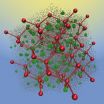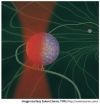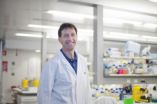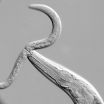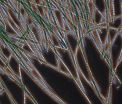RUB researchers find over active enzyme in failing hearts
The enzyme CaM kinase II relaxes the muscle cells
2013-01-17
(Press-News.org) A certain enzyme, the CaM kinase II, keeps the cardiac muscle flexible. By transferring phosphate groups to the giant protein titin, it relaxes the muscle cells. This is reported by researchers led by Prof. Dr. Wolfgang Linke of the Institute of Physiology at the Ruhr Universität in the journal Circulation Research. In failing hearts, which don't pump enough blood around the body, the scientists found an overly active CaM kinase II. "The phosphorylation of titin could be a new starting point for the treatment of heart failure" Prof. Linke speculates.
Titin phosphorylation determines the mechanical tension of the muscle cell
Titin is the largest protein in the human body, and it acts like a spring which tenses or relaxes the muscle cell. The attachment of phosphate groups to specific titin sites - known as phosphorylation - relaxes the cell. It was already known that the calcium/calmodulin-dependent kinase II, CaM kinase II for short, phosphorylates several proteins in heart cells. Whether it also targets the spring protein titin, has now been examined by the researchers in Bochum.
CaM-Kinase II phosphorylates the giant protein titin
For the study, the researchers used heart cells of "normal" mice, mice that have no CaM kinase II, and mice that produce more CaM kinase II than usual. In cells without the enzyme, titin phosphorylation was reduced by more than 50 percent compared to the normal state. In cells with excess enzyme, however, titin phosphorylation was twice as strong as in normal cells. The CaM kinase II is therefore crucial for the attachment of phosphate groups to the giant protein titin. Linke's team identified two regions within the flexible segment of the titin molecule which are phosphorylated by the enzyme, namely the PEVK and N2Bus region. These sites contain several amino acids of the type serine and threonine, which have changed little in the course of evolution.
The work of the CaM kinase II determines cell stiffness
In further analyses, the research team also showed that a lack or an excess of CaM kinase II affected the stiffness of the muscle cells. Cells without the enzyme were stiffer, cells with the enzyme more flexible. If they added CaM kinase II to cells that were not able to produce the enzyme themselves, these relaxed. In failing human hearts, the team found increased activity of CaM kinase II in comparison with healthy hearts, and thus excessive phosphorylation in the PEVK and N2Bus titin regions. "This seems to alter the mechanical properties of the human heart muscle", says Wolfgang Linke.
###
Bibliographic record
N. Hamdani, J. Krysiak, M.M. Kreusser, S. Neef, C.G. dos Remedios, L.S. Maier, M. Krüger, J.Backs, W.A. Linke (2012): Crucial role for Ca2+/Calmodulin-dependent Protein Kinase-II in regulating diastolic stress of normal and failing hearts via Titin phosphorylation, Circulation Research, DOI: 10.1161/CIRCRESAHA.111.300105
Figure online
A figure related to this press release can be found online at: http://aktuell.ruhr-uni-bochum.de/pm2013/pm00013.html.en
Further information
Prof. Dr. Wolfgang Linke
Department of Cardiovascular Physiology
Institute of Physiology
Faculty of Medicine at the Ruhr-Universität
44780 Bochum, Germany
Editor: Dr. Julia Weiler END
ELSE PRESS RELEASES FROM THIS DATE:
2013-01-17
In developing these novel self-assembling materials, postdoc Barbara Capone has focused on the design of organic and inorganic building blocks, which are robust and can be produced at large scale. Capone has put forward, together with her colleagues at the Universities of Vienna and Mainz, a completely new pathway for the construction of building blocks at the nanoscale.
"Soft Lego" orders in crystal structures
The team of researchers has shown that so-called block copolymer stars – that means polymers that consist of two different blocks and they are chemically ...
2013-01-17
Caesarean section increases the risk of persistent pelvic girdle pain after delivery compared with vaginal delivery, according to a new study from the Norwegian Institute of Public Health.
Caesarean section rates are increasing worldwide, and this trend has partly been explained by women's requests for planned caesarean section without a medical reason. Pregnancy-related pelvic girdle pain has been associated with increased preference for caesarean section and with increased planned caesarean section rates.
"Some women with severe pelvic girdle pain might fear that ...
2013-01-17
To live is to move. You strike to swat that irritable mosquito, which skilfully evades the hand of death. How did that happen? Who moved your hand, and what saved the mosquito? Enter the Molecular Motors, nanoscale protein-machines in the muscles of your hand and wings of the mosquito. You need these motors to swat mosquitoes, blink your eyes, walk, eat, drink... just name it. Millions of motors tug as a team within your muscles, and you swat the mosquito. This is teamwork at its exquisite best.
Paradoxically, a weak and inefficient motor (called dynein) is the one that ...
2013-01-17
Nearly 200 000 light-years from Earth, the Large Magellanic Cloud, a satellite galaxy of the Milky Way, floats in space, in a long and slow dance around our galaxy. Vast clouds of gas within it slowly collapse to form new stars. In turn, these light up the gas clouds in a riot of colours, visible in this image from the NASA/ESA Hubble Space Telescope.
The Large Magellanic Cloud (LMC) is ablaze with star-forming regions. From the Tarantula Nebula, the brightest stellar nursery in our cosmic neighbourhood, to LHA 120-N 11, part of which is featured in this Hubble image, ...
2013-01-17
Researchers have identified a complex of proteins that promotes the growth of some types of colon and gastric cancers, and shown that medications that block the function of this complex have the potential to be developed into a new treatment for these diseases.
The complex of proteins, known as mTorc1 (mammalian target of rapamycin complex 1), has previously been implicated in the development of some other cancers but this is the first time it has been shown to promote the growth of colon and gastric cancers that are associated with inflammation.
Dr Stefan Thiem and ...
2013-01-17
Every 30 seconds somebody in the world is amputated as a consequence of foot complication due to diabetes. A new study at Sahlgrenska Academy, University of Gothenburg, Sweden, confirmes that shoe inserts, podiatry, regular checkups and other simple interventions can reduce the number of amputations by more than 50%.
Orthotic researchers at Sahlgrenska Academy, University of Gothenburg, have studied diabetic foot complications ever since 2008. They have focused on protecting the foot from overloading the foot sole in order to minimize the risk of ulcers, which may eventually ...
2013-01-17
This press release is available in German.
Researchers in the group of Ralf Sommer at the Max Planck Institute for Developmental Biology in Tuebingen, Germany, have for the first time been able to identify neuronal correlates of behaviour by comparing maps of synaptic connectivity, or "connectomes", between two species with different behaviour. They compared the pharyngeal nervous systems of two nematodes, the bacterial feeding Caenorhabditis elegans and the predator/omnivore Pristionchus pacificus and found large differences in how the neurons are "wired" together.
A ...
2013-01-17
A study in The Journal of General Physiology examines the consequences of muscle activity with surprising results, indicating that the extracellular accumulation of potassium that occurs in working muscles is considerably higher than previously thought.
Muscle excitation involves the influx of sodium ions and efflux of potassium ions. Although the fraction of ions that cross the muscle membrane with each contraction is minute, repeated activity can lead to substantial changes in the intracellular and extracellular concentrations of sodium and potassium ions. The extent ...
2013-01-17
Cyanobacteria belong to the Earth's oldest organisms. They are still present today in oceans and waters and even in hot springs. By producing oxygen and evolving into multicellular forms, they played a key role in the emergence of organisms that breathe oxygen. This has, now, been demonstrated by a team of scientists under the supervision and instruction of evolutionary biologists from the University of Zurich. According to their studies, cyanobacteria developed multicellularity around one billion years earlier than eukaryotes – cells with one true nucleus. At almost the ...
2013-01-17
People who take cocaine over many years without becoming addicted have a brain structure which is significantly different from those individuals who developed cocaine-dependence, researchers have discovered. New research from the University of Cambridge has found that recreational drug users who have not developed a dependence have an abnormally large frontal lobe, the section of the brain implicated in self-control. Their research was published in the journal Biological Psychiatry.
For the study, led by Dr Karen Ersche, individuals who use cocaine on a regular basis underwent ...
LAST 30 PRESS RELEASES:
[Press-News.org] RUB researchers find over active enzyme in failing hearts
The enzyme CaM kinase II relaxes the muscle cells
